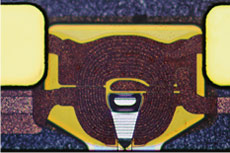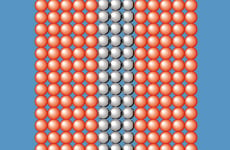Nanotechnology
|
The electrons in the illustration are represented by small magnets as it is their magnetic qualities that give rise to giant magnetoresistance. The magnetic moment in the electrons is the result of their internal “rotation”, spin, that can point upwards or downwards. Here the electric current is divided into one part that consists of spin-up electrons and one consisting of spin-down electrons. The increased resistance in the magnetic material for electrons with the “wrong” spin is represented in the illustration as a hole pointing in the wrong direction that makes it impossible for the electrons to get through. |
Nanotechnology has been developed in the wake of the growth of the semi-conductor industry. One requirement consists of the vacuum techniques that make it possible to deposit judicious amounts of material to create thin layers. From the 1970s and onwards nanometre thin layers could be manufactured of only a few atoms thickness. A nanometre is one millionth of a millimetre.
|
Nobel Prizes and laureates
Six prizes were awarded for achievements that have conferred the greatest benefit to humankind. The 12 laureates' work and discoveries range from proteins' structures and machine learning to fighting for a world free of nuclear weapons.
See them all presented here.


